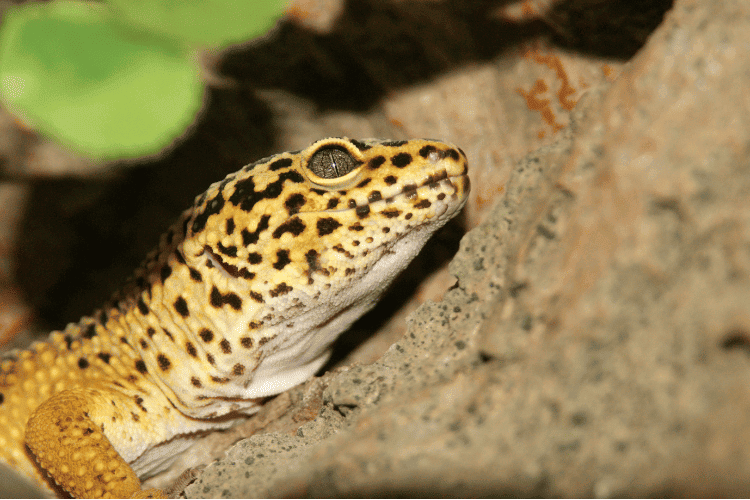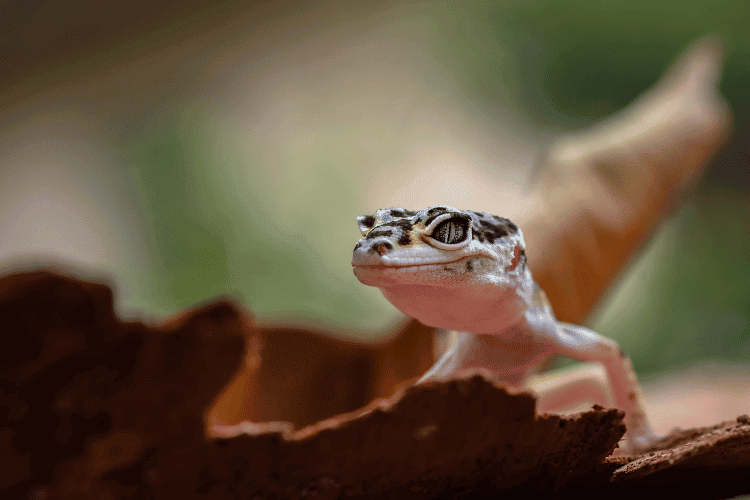
Have you ever gazed at your Leopard Gecko, marveling at its intricate patterns and captivating beauty, only to notice something unsettling—a dark, mysterious spot – this is the “black spot of death”.
This intriguing yet concerning phenomenon refers to the sudden appearance of black or dark spots on your gecko’s body. Far from being just a random occurrence, these spots can serve as crucial indicators of potential health issues that require immediate attention.
In this article, we’ll uncover the possible reasons behind the mysterious black spots and the steps you can take to address, treat, and prevent them.
What Do Black Spots of Death Look Like?
Black spots of death appear as miniature ink blots, emerging seemingly out of nowhere on the gecko’s body.
They can manifest in various areas—ranging from its back to its tail and even its limbs.
These spots might evoke comparisons to freckles or moles, albeit in a deep black hue.
They stand out due to their darker shade in comparison to the Leopard gecko’s regular markings. They might even possess a slightly distinct texture, possibly resembling a minor elevation on the skin.
Causes of the Leopard Gecko Black Spot of Death
Black spots can show up for a bunch of reasons, from infections to injuries. Here are the most common factors that contribute to the appearance of these marks:
Stress and Environmental Factors
Just like us, Leopard geckos can get stressed due to changes in their environment. Things like sudden shifts in temperature, lighting, or even moving their habitat around can lead to these black spots showing up.
When it comes to temperature, troubles arise when there are rapid changes or when your gecko is exposed to an environment that’s excessively hot or cold. These conditions can cause stress, throwing their delicate balance off-kilter and ultimately resulting in leopard gecko black spot of death.
Likewise, inadequate exposure to natural sunlight or poor-quality artificial lighting can disrupt your gecko’s internal clock. This disruption to their routine contributes to stress and can play a part in the emergence of distinct black spots.
Territorial dynamics also factor in. While Leopard geckos are generally low-key creatures, they still value their personal space. If they share their habitat with other geckos and a territorial dispute arises, the resulting stress can manifest as black spots.
Infections
Sometimes, black spots can be a signal that something not-so-nice is going on in a gecko’s system. Bacterial, fungal, or viral infections might be at play. It’s their body’s response to an internal battle, and the spots can be a sign that they’re fighting something off.
Common signs of bacterial infection include:
- Loss of appetite or poor appetite
- Lack of droppings
- Difficulty breathing
- Swollen eyes or discharge
- Weakness
- Skin abnormalities
Parasites
Another potential reason behind the appearance of black spots on a Leopard gecko is the presence of parasites.
These tiny troublemakers, such as pinworms and coccidia, can sneak their way into the gecko’s system and cause some issues.
Two common routes for parasitic transmission are through untidy surroundings and contact with infected geckos.

An unclean habitat creates an ideal environment for parasites to thrive, so regular cleaning and maintenance are essential.
Impaction
Impaction in geckos refers to a condition where the digestive tract becomes blocked due to the ingestion of indigestible or oversized materials.
This can include things like substrate particles (bedding materials), insects that are too large, or other foreign objects.
When impaction occurs, it can disrupt the gecko’s ability to properly digest food and pass waste. The pressure and stress on the digestive tract can lead to these blood vessels breaking, resulting in the appearance of black spots.
Internal Bleeding
When blood vessels inside the gecko’s body rupture, blood leaks into the surrounding tissues and accumulates beneath the skin.
The darkened blood creates the appearance of black or very dark spots on the gecko’s skin. These spots are a sign of an underlying health issue, which can include injury, disease, or organ damage.
Internal bleeding in geckos is caused by various factors, including:
- Injuries or accidents that result in physical trauma; i.e., falls, rough handling, or collisions with objects
- Fractures leading to hemorrhage
- Weak blood vessels
- Foreign object ingestion
Shedding Issues
When shed skin doesn’t come off completely, it can constrict blood flow, causing blood vessels to rupture and dark spots to appear. These spots can range from red to black and are called stuck shed spots or hemorrhagic patches.
To prevent these problems, provide your gecko with proper shedding conditions, such as humidity and a shedding box. If retained shed skin occurs, gentle assistance and veterinary care may be necessary to ensure the gecko’s well-being.
Metabolic Bone Disease
Metabolic Bone Disease (MBD) is a condition in reptiles, including geckos, characterized by the inadequate metabolism of
While black spots are not a direct result of MBD, they can be indirectly related due to the effects of
Geckos with MBD may experience skin lesions and wounds more frequently due to their weakened bones. These lesions can become inflamed or infected, potentially resulting in dark or discolored spots on the skin.
How to Treat Black Spots on Leopard Geckos
Addressing black spots on leopard geckos requires a systematic approach that considers the underlying cause. Here’s a step-by-step guide to effectively treat and care for geckos exhibiting black spots:
Identify the Cause of Leopard Gecko Black Spots
Begin by understanding the root cause of the black spots. Are they the result of infections, shedding issues, or other factors?
Seek professional guidance from a veterinarian with experience in reptile care to accurately diagnose the issue and receive appropriate treatment recommendations.
Tailored Treatments
Once the cause is determined, proceed with targeted treatments:
If the black spots are indicative of infections, for example, follow the veterinarian’s instructions for administering prescribed antibiotics or antifungal treatments.
For shedding-related concerns, create a humid hide within the enclosure or utilize specialized shedding aids to facilitate the shedding process.
Isolation and Quarantine
In cases of illness, consider isolating the affected gecko in a separate enclosure. Isolation helps prevent the potential spread of diseases to other geckos and offers a controlled environment for the gecko’s recovery.
Improve Habitat Conditions
Maintaining optimal habitat conditions is crucial for a gecko’s well-being.
Ensure the enclosure provides suitable temperature gradients and humidity levels to promote comfort and health.
Regularly clean the enclosure to prevent the growth of bacteria and fungi that could exacerbate skin issues. Make sure to use safe and appropriate substrates to prevent skin irritation or abrasion.

Optimal Nutrition
A well-balanced diet is essential for the gecko’s recovery. Offer insects rich in
Hydration
Geckos have evolved to manage extended periods without drinking directly by absorbing moisture from their surroundings and the food they consume. Despite this adaptation, it’s still important for them to consume water regularly.
Providing a water dish every couple of days ensures they have access to hydration.
Placing them in warm, shallow water for 15 to 20 minutes every two to three weeks help with hydration levels, and supports the healthy shedding of their skin, both of which help prevent the leopard gecko black spot of death.
Stress Reduction
Creating an environment that minimizes stress is paramount during your gecko’s recovery phase. Geckos are sensitive creatures, and their well-being is greatly affected by their surroundings.
To achieve this, start by ensuring a quiet and undisturbed setting. Loud noises or sudden movements can cause unnecessary anxiety, hindering their healing process.
Furthermore, consider limiting your gecko’s handling during this time. While your care and attention are undoubtedly beneficial, giving them space to rest and recuperate without additional disturbances can contribute to their recovery.
A crucial aspect of reducing stress is providing an enclosure that caters to their comfort. Regular maintenance, cleanliness, and appropriately sized habitats are foundational.
Incorporating hiding spots within their enclosure can create a sense of security, helping them feel at ease even during their recovery.
Wrapping Up
The presence of dark or black spots on a leopard gecko’s skin, often referred to informally as “black spots of death,” is an alarming indicator of serious health issues.
These spots are not a natural feature but rather signify underlying problems such as severe infections, organ failure, or advanced metabolic bone disease.
The emergence of these dark spots serves as a warning sign, suggesting critical health deterioration. When such spots are observed, immediate veterinary attention is imperative to diagnose the root cause and provide appropriate treatment.




